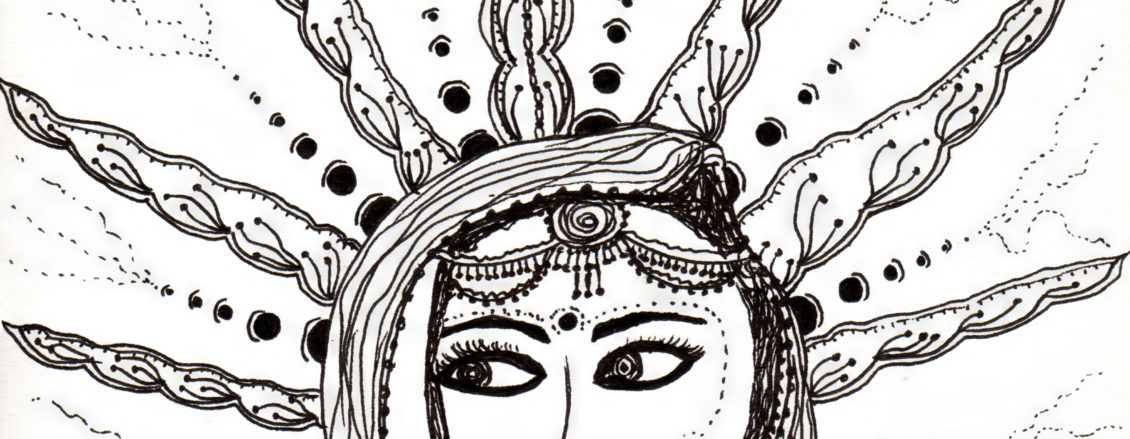
Featured Image: Close up of Sunshine Sari by Leigh
Started on 19 Feb 2019
Please note that this is an ongoing compilation of teaching techniques I have observed my teachers using on us during the Teaching & Learning and Inclusive Teaching & Learning Practices Units. There may also be some techniques I have observed from my colleagues in Foundation Diploma at CCW. This list will be updated repeatedly as I see more and learn more.
| WHAT | Practical WHY | Theory WHY |
| Hand out fidget toys | To make listening and focusing easier. Works for those who hate sitting still for prolonged periods. | Creates a more welcoming learning environment that feels more accepting of ‘alternative’ learning strategies – UAL Disability Service |
| Groups of 3 using intersecting circles | Getting to know you exercise to help the group find common ground, a way to relate to each other on as deep or superficial level as they like. Works to ensure no one can remain invisible in the group. | Builds learning community – Hooks[i]Education is personal – Ken Robinson[ii] |
| Blind-drawing portraits
| Puts everyone on an even playing field. Makes students really notice each other – you can’t stare at someone’s face without stopping for 2 minutes and not remember them! Works for those who prefer social interaction, and anyone feeling overwhelmed by the abilities of others in the group. | Setting the tone for the learning community, making sure every voice knows that it has a place. – Hooks Opening activity in a Teaching & Learning Lecture |
| 5 picture introductions | To get all the students in the group to learn about each other. Get students using technology. Gets students thinking about what’s most important for them when teaching and learning. Works for visual thinkers. | Creates Learning community. Gives everyone a chance to tell their story. Helps the tutor learn more about each student. – Hooks Opening activity in a Teaching & Learning Lecture |
| How do you behave in a group – cards & string exercises | To get students at each table to interact and warm to each other by hearing and sharing their views on the homework. To make each of student aware of how they interact with others, and how that affects the group dynamic. To highlight how each student’s behaviour in a group is different. To get students to discuss the homework (if you didn’t do it, you’d be like a fish out of water!) Works for visual thinkers, would-be philosophers, those who like to be invisible and those who like to be visible. | Ethics of Play, interaction and the completion of having someone recognise what you present. – Gadamer via Vilhauer[iii] Opening activity in a Teaching & Learning Lecture |
| Work in pairs to decipher a quote or poem that makes the point or raises a specific question. | Creates group discussion. Sets up many interpretations to be picked apart/pondered. Works well for those inclined to linguistic and logical intelligences. | Gardner’s Multiple Intelligences[iv] Opening activity in a Teaching & Learning Lecture |
| Peer Evaluations on A4 sheets next to the finished Artwork | To help students see how their artwork is perceived by various people. To strengthen a supportive, constructive learning community. To save teaching time. To keep everyone engagement when conducting assessments in a large group. To allow students to see and interrogate their peers’ work. A great technique for those who hate sitting still. | Learning community – Hooks Play, engagement, recognition, completion of an artwork – Gadamer via Vilhauer Adjusting thinking based on feedback – Hermeneutic Circle? Feedback Activity at Foundation Centre Design lecture |
| Ask students to provide examples of a topic/point | To help students know that their stories matter, they have a voice in this classroom and their voices are heard. To help students learn more about each other. To build the learning community that nurtures and supports. To create discussion in the classroom. To create awareness and acceptance of diversity and diverse experiences leading to varying viewpoints. | Validates everyone’s experience so no one feels experiential essentialism, is their only refute that will be heard. – Hooks on Fuss Show the value and power of combining experience AND theory. As neither is as strong without the under-pinning of the other. – Giroux via Hooks In line with UAL’s Inclusive policies. – UAL Equality Policy |
| Begin with a group activity that is a light ice breaker. | To give late comers an additional 5-10mins to arrive and get settled without missing anything crucial. (I could argue then they should get there on time, but in the end isn’t my objective to help as many students as possible? So I will still have to help them after or later in the term.) To give students who are present an opportunity to relax into the class, get to know colleagues. This almost creates a buffer between the what’s happened so far in their day and the class they are about to start. | Opening activity in a Teaching & Learning Lecture |
| End class 10-15 mins early to allow for questions, especially if I need to leave promptly for some reason. | Announcing this lets students know I’m making time for them. To subtly indicate that in this learning community we respect each others’ time. | Activity in a Teaching & Learning Lecture Learning communities – Hooks |
| Lights on and off, on and off Kazoo, Kids Blower Yodel Music | Ways to get the attention of everyone in a large room. Bring students attention back to the teacher.
| Activity in a Teaching & Learning Lecture Ideas of mine that I’ve added |
| Timeline of events that everyone contributes post-its to, then teacher points out what was correct, what was missing. Takes class through entire timeline. | To add a little movement to a sedentary session. To encourage collaboration/ group work, getting-to-know-others activity. To learn the development/evolution/timeline that’s being taught | Activity in a Teaching & Learning Lecture Learning through collaboration – Ken Robinson |
| Food sharing (with allergy warnings & H&S advisories) | To help different cultures to meet. Food creates community. In presenting their food, they have to share about themselves, about their upbringing, about their heritage and culture. | Education is personal – Ken Robinson |
| Project Guidance: Pathway leader discusses the work from either end – your context and reason for starting the work OR the other end the work you want to create and then work backwards to why | Generate more in-depth approach to projects Show students how to approach a problem from different directions Consider the different thinking processes students employ | Multiple intelligences – Gardener Inclusive Teaching Practice[v] – Richards & Halliday |
| Course Planning: Spread assignments out so due dates spread across the course | Avoids building up unnecessary pressure for students with multiple deadlines all at once. Avoids creating a situation where students grades depend on one ‘performance’ on a specific ‘test’. | Inclusive Teaching Practice – Richards & Halliday |
| Know what your students are working on | Preparation for Chaos – If you know the topic your student is addressing could create some controversy in class, come prepared to deal with all eventualities. If the discussion goes to A, I will do B. If it moves to C, I will do D. Ensures no student feels “left for the wolves” during discussions on sensitive topics Lets all students know what will and won’t be allowed in class Sets mood for Learning Community and hopefully future working habits and attitudes of students. | Inclusive Teaching Practice – Richards & Halliday Learning communities – Hooks |
| Teaching on the move… as students follow you. (Only suitable for small groups?) | Keeps students awake. Taps those into kinaesthetic learning. | Thinking Teaching[vi], microteaching exercise |
| Blogs Post-it notes In-session questions | Varied forms of feedback to ensure engagement with process | Thinking Teaching, microteaching exercise |
| Fill in the Pronouns Game -Tell a story involving someone in an ‘everyday’ situation and let listeners guess the pronoun for the main character. | To show up our inherited biases where gender is concerned. | Thinking Teaching, microteaching exercise |
| Offer large unusual writing and drawing implements | Creates an atmosphere of fun and curiosity instantly. Barrier and walls might drop a bit in the face of an opportunity to explore. | Teaching & Learning Unit[vii] – Microteaching Session, Peer observation and feedback |
| 2 Stars and a Wish | A constructive way to give feedback so that participants are forced to highlight twice as much good as they find bad in whatever they are critiquing. | Teaching & Learning Unit – Microteaching Session, Lecturer’s suggestion for feedback |
| Go ass backward! Plan your teaching session backwards – from desired end result back towards start of session | To ensure that you achieve learning outcomes, keep yourself on track and don’t get carried away with teaching ideas | Teaching & Learning Unit – Microteaching Session, Tutor’s feedback |
| Vege printing – a great way to start with play and curiosity before adding theory | So that participants do not form set expectations. They just have fun and then see the meaning in what they have been doing at the end. | Teaching & Learning Unit – Microteaching Session, Peer observation and feedback Rose in the Salad Bowl -Bruno Munari[viii] |
| Notes, handouts, Moodle, etc | Avoids students missing out on references and key advice if they can’t write fast enough, misspell an artist’s name, etc. | Teaching & Learning Unit – Microteaching Session, Peer observation and feedback |
| Learning through objects, especially boxes | Create immediate curiosity and engagement. Ensure the contents of the box are equally as engaging so you continue to build on students interest and sense of exploration. | Teaching & Learning Unit – Microteaching Session, Peer observation and feedback. Object-Based Learning[ix] – Kirsten Hardie |
| Exude confidence (not arrogance) when centre stage | Learning is easier if they aren’t picking up on your own insecurities. Students must feel like they can trust you to guide them to the right information and concepts. | Teaching & Learning Unit – Microteaching Session, Peer observation and feedback |
| With learning outcomes, less is more. | Especially with time restrictions, fewer learning outcomes mean you are more likely to effectively achieve what you set out to do. | Teaching & Learning Unit – Microteaching Session, Peer observation and feedback |
| Windows & Mirrors Exercise: In partners, choose an image that resonates with you, and talk about how it is a mirror or a window for you. Each participant has equal time. | Consider learning environments as a series of mirrors and windows. Learning is best when we encounter both the familiar and the unfamiliar. When this is out of balance, in either direction, inequity exists. A clear timer for each participant – Equity of time, no one’s voice is overheard. By examining our own windows and mirrors we can understand other people’s stories and differences. | Peer review of UAL event – “Addressing Attainment Differentials in Higher Education”[x] Thank you S! |
| Confident Body Language for Teachers | “When teachers are comfortable in a classroom they tend to make more eye contact, use more open body language, move more slowly and talk less. Students pick up on these signs (usually without being consciously aware of it), and they’ll reflect everything back at you. So if it’s possible for you to act comfortable (I find the open body language is the easiest thing to start the ball rolling; put your shoulders back and down, open your hands, tilt your chin up), your students will feel more comfortable.” – OB2 Form Tutor Observation from L Jordan, 5 Feb | As the teacher, I set the tone for the Learning environment. “If you act tense, the tension levels in the whole room will rise.” – OB2 Form, Tutor Observation, 5 Feb 2019 This is counter productive for everyone |
–More to come!
References so far…
[i] Hooks, B (1994) Teaching to Transgress: Education as the Practice of Freedom. Available at: https://www.audible.co.uk/ (Downloaded: 26 January 2019).
[ii] Robinson, K. (2006) Do School Kill Creativity? Available at: https://www.ted.com/talks/ken_robinson_says_schools_kill_creativity Accessed: Summer 2018 (I think, definitely pre-PgCert)
[iii] Vilhauer, M. (2010) Gadamer’s Ethics of Play: Hermeneutics and the Other. Plymouth: Lexington Books, Chp 3.
[iv] Armstrong, T (2018) Multiple Intelligences. Available at: http://www.institute4learning.com/resources/articles/multiple-intelligences/ (Accessed: 9 February 2019)
[v] University of the Arts London: Inclusive Teaching & Learning in Higher Education (2019) Available at: https://www.arts.ac.uk/about-ual/teaching-and-learning-exchange/professional-development/course-units/inclusive-teaching-and-learning-in-higher-education-elective-unit (Accessed: 29 March 2019). I am currently enrolled in this course.
[vi] University of the Arts London: Thinking Teaching (2019) Available at: https://www.arts.ac.uk/about-ual/teaching-and-learning-exchange/professional-development/thinking-teaching (Accessed: 29 March 2019). I attended this course from 11-12 December 2018.
[vii] University of the Arts London: Teaching & Learning Unit (2019) Available at: https://www.arts.ac.uk/about-ual/teaching-and-learning-exchange/professional-development/course-units/teaching-and-learning (Accessed: 29 March 2019). I am currently enrolled on this course.
[viii] Presentation by peer about Bruno Munari’s techniques from his book “Rose in the Salad Bowl”. I have not read this book so didn’t feel that I could reference it here as if I’d read it.
[ix] Hardie, K (2015) Wow: The power of objects in object-based learning and teaching Available at: https://www.heacademy.ac.uk/system/files/kirsten_hardie_final.pdf (Accessed: 12 March 2019)
[x] Katt, S. (2019) ‘Addressing Attainment Differentials in Higher Education – A UAL Event, 5.02.19’, 14 February 2019. Available at: https://serenajk.myblog.arts.ac.uk/2019/02/14/addressing-attainment-differentials-in-higher-education-ual-event-5-02-19/ (Accessed: 4 April 2019).
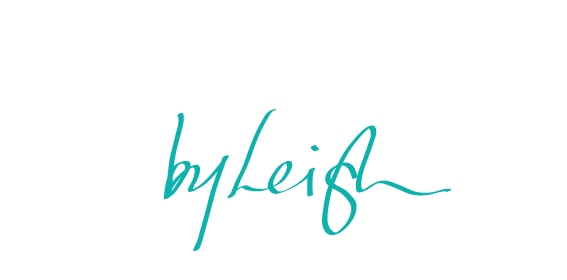
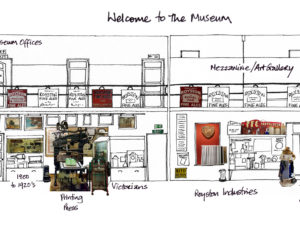
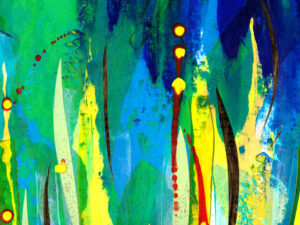
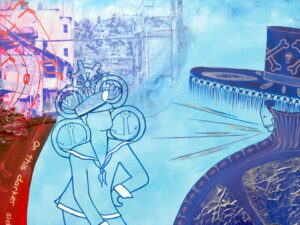
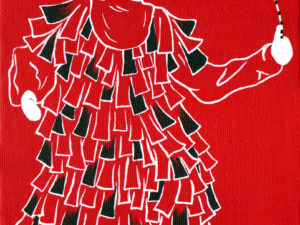
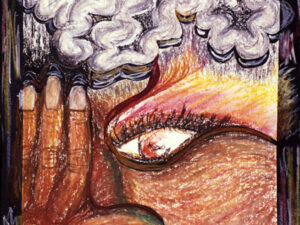

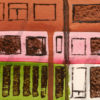
Exhibition Review – Blowtorching the Bitten Peach